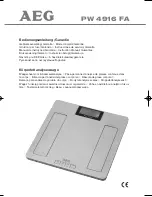
27
Operating: CW2P | CW2P | CW1NFS | CW2FS
Counting
Z
With the Counting application, you can
determine the number of parts that
each have approximately equal weight.
Features:
– Store the weight on the weighing
instrument as reference weight
– Enter reference weight using
a bar code scanner
– Enter tare weight using a bar code
scanner
– Automatic reference sample updating
(user-definable)
– Counting with two weighing
instruments
– Toggle the display between piece count
and weight by pressing
w
– Info mode for display of average piece
weight and reference sample quantity
by pressing
w
(> 2 sec)
Before the quantity on the weighing
instrument can be calculated, the
average piece weight must be entered
in the application. There are 2 ways
to do this with the Combics:
– By placing the number of parts defined
as the reference sample quantity on
the weighing instrument and pressing
O
to store the average piece weight.
The reference sample quantity
is shown in the numeric display, and
can be changed by pressing
r
.
How the reference weight is calculated
depends on the menu setting for reso-
lution (3.9). Either the value is rounded
off in accordance with the display
resolution, or the display resolution is
increased 10-fold (+1 decimal place)
or 100-fold (+ 2 decimal places), or
maximum internal resolution is applied.
– By entering the reference piece
weight (i.e., the weight of one piece)
using a bar code scanner (menu setting:
“Setup> Bar code > Store value as
reference (
ref
)"). In this case, the value
is stored as a reference automatically,
without pressing the
O
key.
This value remains active in the
reference memory until you delete it by
pressing
c
, overwrite it or until you
select a different application. It also
remains in memory when you switch to
a different application program, or
switch off the Combics.
– Tare function:
1) If you store a tare (weight value) by
pressing the
)
key, you can later
enter a tare value manually. The tare
value you enter is added to the stored
tare value.
Setting: menu code 3.25.1 (factory
default)
2) A tare value entered manually over-
writes a stored tare value (weight value).
If you enter a tare value manually, a
tare value (weight value) stored later
overwrites the manually entered value.
Setting: menu code 3.25.2
Operating menu setting:
APPL
:
Z
:
3.25.
Application Parameters: Counting
3. 5.
Minimum Load for Automatic Taring and
Automatic Printing
3. 5. 1 * 1 digit
3. 5. 2
2 digits
3. 5. 3
5 digits
3. 5. 4
10 digits
3. 5. 5
20 digits
3. 5. 6
50 digits
3. 5. 7
100 digits
3. 5. 8
200 digits
3. 5. 9
500 digits
3. 5.10
1000 digits
3. 6.
Minimum Load for Initialization
3. 6. 1 * 1 digit
3. 6. 2
2 digits
3. 6. 3
5 digits
3. 6. 4
10 digits
3. 6. 5
20 digits
3. 6. 6
50 digits
3. 6. 7
100 digits
3. 6. 8
200 digits
3. 6. 9
500 digits
3. 6.10
1000 digits
3. 7.
Automatic Taring: 1st Weight Tared
3. 7. 1 * Off
3. 7. 2
On
3. 8.
Start Application with Most
Recent Application Data
when Combics is Switched On
3. 8. 1
Automatic (on)
3. 8. 2 * Manual (off)
3. 9.
Resolution for Calculation
of Reference Value
3. 9. 1 * Display resolution
3. 9. 2
Display reso 1
decimal place
3. 9. 3
Display reso 2
decimal places
3. 9. 4
Internal resolution
3.11
Storage Parameter
3.11. 1* At stability
3.11. 2
At increased stability
3.12.
Reference Sample Updating
3.12. 1
Off
3.12. 3* Automatic
3.13.
Reference Weighing Instrument
3.13. 1* No reference instrument selected
3.13. 2
WP1
3.13. 3
WP2
3.25. Tare
function
3.25. 1* The tare value entered is added to
the stored tare value
3.25. 2
Overwritable tare value
Содержание CH1NE
Страница 102: ...CH Platform Dimensions Scale Drawings CH G CH E 102 ...
Страница 108: ...108 ...
Страница 109: ...109 ...
Страница 110: ...110 ...
Страница 111: ...111 ...
Страница 112: ...112 ...
Страница 113: ...113 ...
Страница 114: ...114 ...
Страница 115: ...115 ...
Страница 116: ...116 ...
Страница 117: ...117 ...
Страница 118: ...118 ...
Страница 120: ......
















































